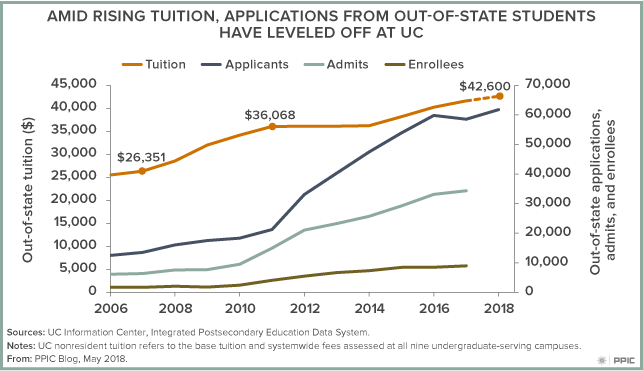After the Great Recession, growing demand among out-of-state students, including international students, helped the University of California (UC) offset funding cuts. But as nonresident tuition goes up, and as UC places caps on enrollment that trend may be changing—raising questions about the stability of what’s now an important source of university revenue.
The recession brought heavy cuts to state education budgets, and public universities in California and nationwide increased tuition substantially to compensate. UC implemented cost-saving strategies and looked for other sources of revenue. Campuses began enrolling more out-of-state students, who pay an extra $20,000 or more in supplemental tuition every year. As a result, nonresident applications, admits, and enrollees all more than doubled from 2010 to 2016, and out-of-state students became a reliable—and growing—source of revenue. UC states that this additional revenue helps provide funding to enroll California residents.
From 2011 to 2014, tuition was frozen for all students as the state recovered from the recession, but nonresident tuition started to grow again in 2014. By 2017, nonresident tuition surpassed $41,000, leaving it comparable to the most expensive public universities in the nation (Michigan: $47,476; Virginia: $46,643) and to the most expensive private schools in the state (Stanford: $48,987; University of Southern California: $53,448). UC tentatively approved another increase in March that would put nonresident tuition at about $42,600, but may scale that back if the state kicks in more funds.
However, growth in out-of-state demand may be starting to slow at UC. The number of applications from out-of-state students, which had grown steadily since 2010, dropped in 2017, though it then rebounded to previous levels in 2018.

There are many possible reasons for the potential slowing growth in demand among out-of-state students. UC has put a yearly cap on nonresident enrollment and stopped giving out-of-state students financial aid, which means they pay the full price of tuition plus living expenses, about $61,000 total. In contrast, private institutions do give financial aid, so even with higher tuition, they may be cheaper for some students overall. For example, the average estimated net cost for students who receive financial aid at the University of Southern California is $32,932, and at Stanford the net cost is $16,695.
Given the cap on out-of-state students—as well as the potential slowdown in the growth of demand—the University of California may have to look to other sources to increase revenue for its campuses.





